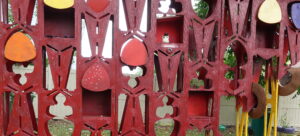We continue the series on walking Buffalo, from the intrepid couple who walked every day—no matter the weather—in the first 30 months of Covid. They think (without being systematic) they walked every street in Buffalo, and many in other cities and towns, taking some 20,000 photos, some of which are shared in this series. While not itineraries, we hope to encourage others to “walk the walk,” to see, observe and appreciate Buffalo—and beyond. William Graebner and Dianne Bennett are also 5 Cent Cine’s film critics, here.
Today’s photo-essay: Queen City Sculpture
Walking the city’s streets since March of 2020, we couldn’t help but notice (or confirm) how creative and artistic Buffalonians are—creative at the yard-by-yard, street-by-street level, on the West Side, the East Side, and Riverside, in the Old First Ward, in Kaisertown–and beyond. Among other talents, they’re sculptors. From iron and wood and cloth (and, as we noted in an earlier photo-essay, rubber tires), they sculpt.
Our approach here, as it was in a prior photo-essay on murals, is to focus on sculptures that most of our readers will likely not have seen. We love the towering “phone” piece in front of the Essex Street Pub (see below), the modernist iron planter down the block on Essex, the colorful metal rooster in front of the Buffalo Distilling Company in Larkinville, and several works that owe their existence to Rick Smith and his Rigidized Metals Corporation, adjacent to Silo City. And we understand that there are professional sculptors of considerable talent working in Buffalo.
Instead, we’ll be focused on the “vernacular.” The word derives from the Latin vernaculus, meaning “native” or “indigenous” OR it comes from verna (“home-born slave, native,” a word of Etruscan origin. Or both. Whatever its origins, it refers to work done at the grass roots—mostly, we assume, by ordinary folks with creative inclinations. (It has also occurred to us that a few of the “sculptures” we’ve seen may have been purchased, rather than fashioned in the basement).
It can be difficult to categorize an art work. We found this hubcap pyramid sculpture in an alley off Main Street (a glance at the internet reveals that hubcaps are a not uncommon ingredient of artistic endeavors). Is it “vernacular” in origin, or made for a commercial or institutional purpose?
Just this month, having walked the West Side to the point of intimacy, we came upon a rusted elephant, as well as a “plant” sculpture, or a tiny Stonehenge, made of pieces of iron.
The West Side also produced a face, assembled from industrial parts, and a metal dog, decorated with Mardi Gras beads.
Then, a Rube Goldberg-like contraption, so complex it defies description. This and other pieces have some of the quality of “outsider art”—that is, art produced by self-taught artists who have little interest in the conventions of the traditional art world.
On Prospect Street (if we remember correctly), we found this impressive trio of Sasquatches:
Over on the East Side—likely Riley Street—a cute metal-dog planter caught our attention. Lovejoy yielded a tin man crafted from cans. Shades of “The Wizard of Oz.”
A Tonawanda yard, near Friendship Park, sheltered a larger-than-life plywood deer:
Community gardens sometimes contain a piece of sculpture. A work of rubber tires marks the grounds of a Grassroots Garden on Peckham Street at Lombard Street, west of the Central Terminal. In Riverside, a substantial metal structure anchors the Esser and Henrietta (Streets) Community Garden.
A few of our “native” sculptors have worked with natural materials, and in a variety of ways. Within sight of the Central Terminal, we found a totem-like piece, carved from a tree trunk. Also on the East Side (south of Genesee Street), an animal, perhaps sculpted from a living tree.
We thought “topiary,” the sculpting of bushes into identifiable shapes—usually animals—deserved inclusion. Topiary is very common in Los Angeles, but rare in Buffalo. We found this sculpture—a bush becomes a duck—in Riverside:
Returning to the West Side, this rather unusual—and perhaps religious representation—created from a tree stump.
We extend the notion of sculpture just a bit to include 2 concoctions, both of “people”: one a Bills’ fan, on the bank of the Niagara River in Tonawanda (found February 2021, now gone); and a “monster” in an Old First Ward back yard, ready, one imagines, to fire up the grill.
How to Take a Walk in Buffalo – Look Up! Roofs and Roofers
How to Take a Walk in Buffalo – Buffalo’s Mini-Marts
How to Take a Walk in Buffalo – Remembering 9/11
How to Take a Walk in Buffalo – Street Humor
How to Take a Walk in Buffalo – The Yard as Spectacle
How to Take a Walk in Buffalo – Beware of (the) Dog
How to Take a Walk in Buffalo — Halloween
How to Take a Walk in Buffalo: Little-Known Trails and Paths
How to Take a Walk in Buffalo: Church Board Advice
How to Take a Walk—in Buffalo: Coping with Covid
How to Take a Walk—in Buffalo: Planters
How to Take a Walk—in Buffalo: Christmas Tidings
How to Take a Walk—in Buffalo: Murals… Off-the-Beaten Path
How to Take a Walk—in Buffalo: Scajaquada Creek
How to Take a Walk in Buffalo – Block Clubs
How to Take a Walk—in Buffalo – Black Lives Matter
How to Take a Walk—in Buffalo: Once a Bar
© William Graebner
The post How to Take a Walk—in Buffalo, and Beyond: <strong>Queen City Sculpture</strong> appeared first on Buffalo Rising.

